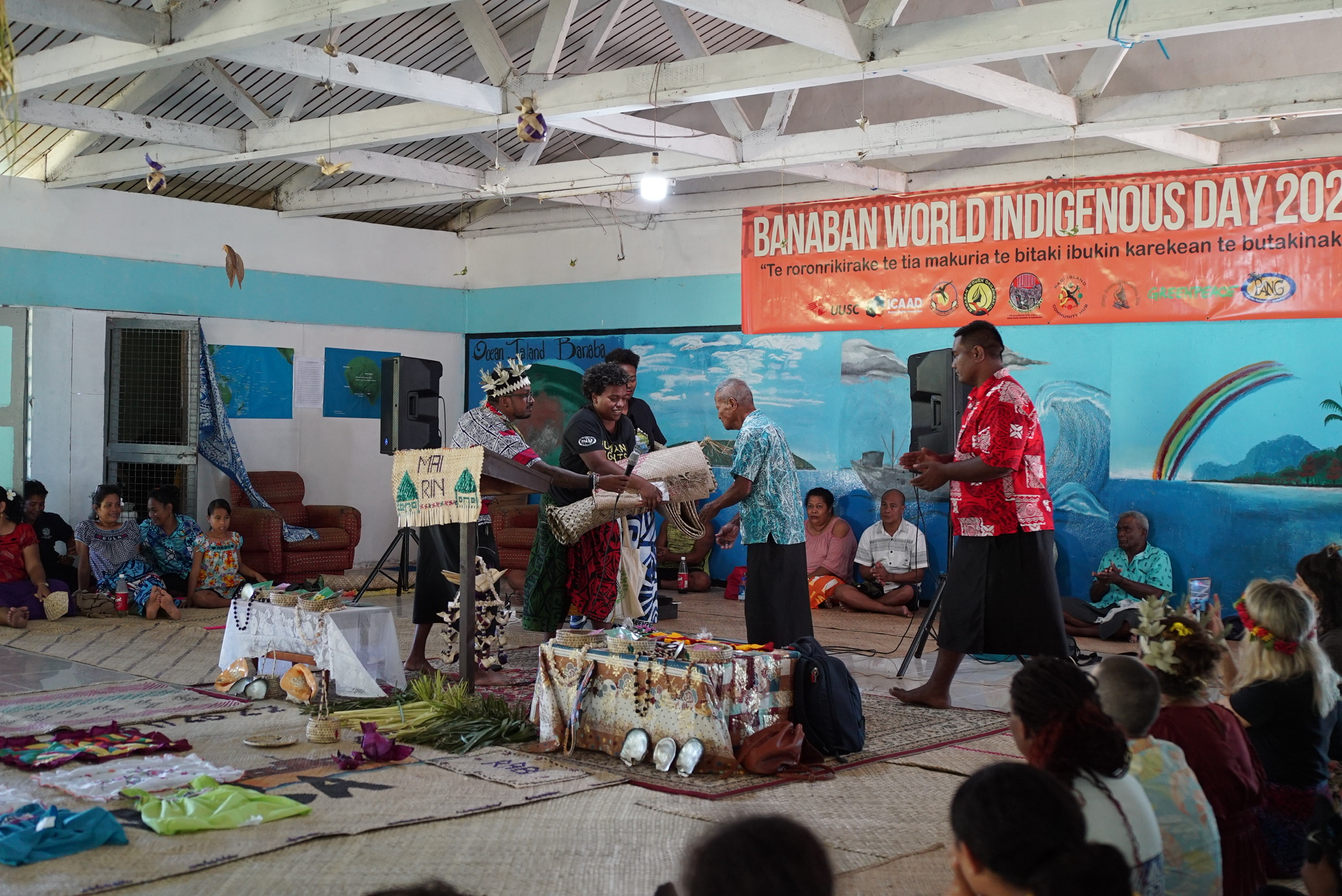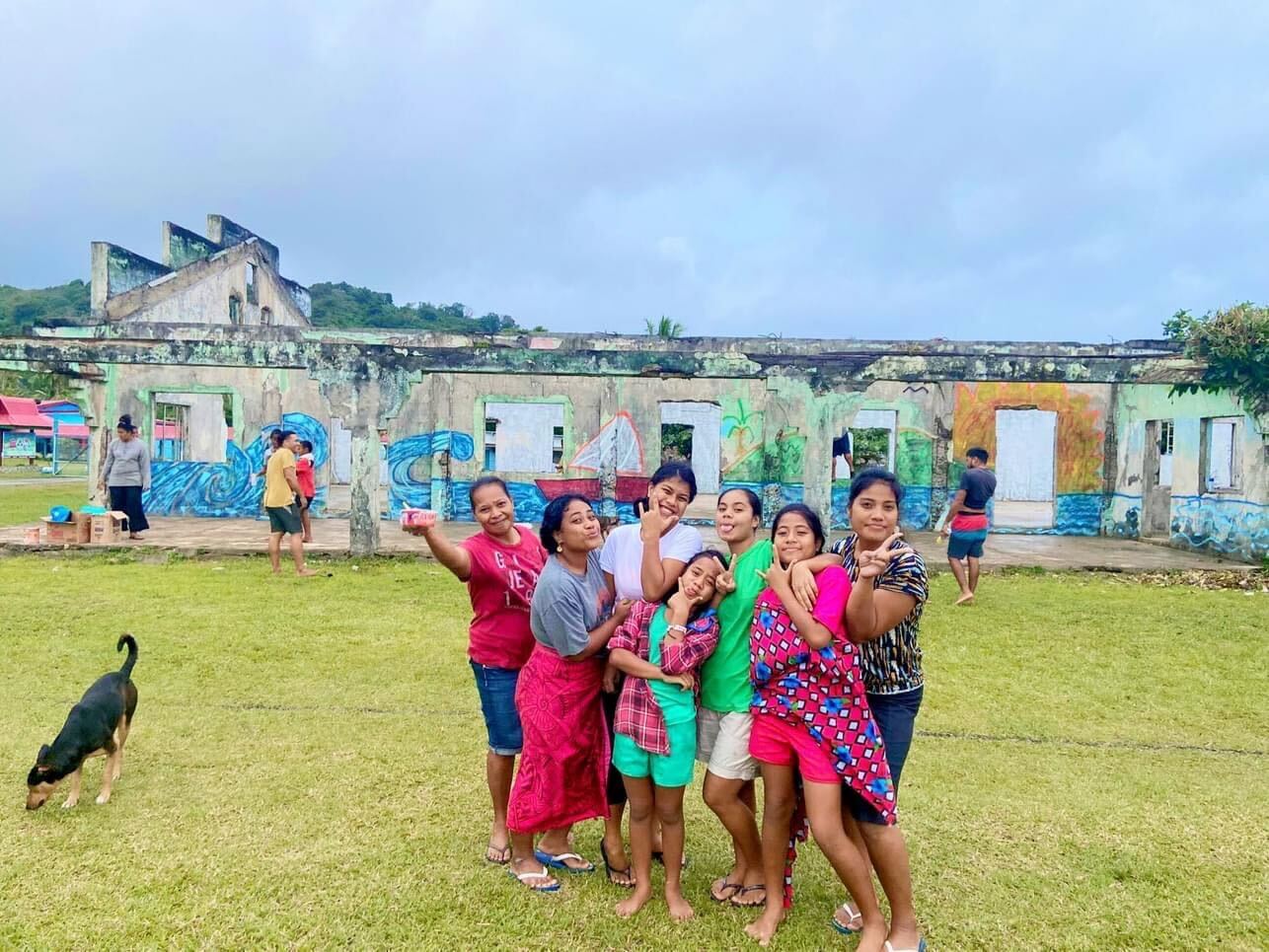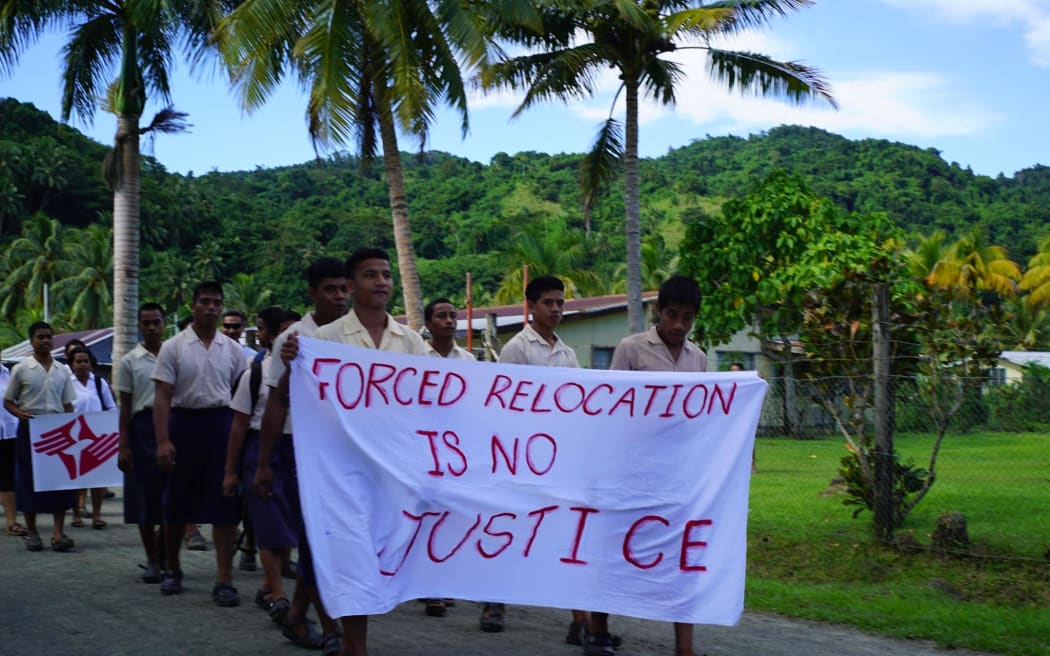
I. The Problem: Climate-Induced Displacement
The effects of the climate crisis are already leading to migration and displacement on a massive scale. Climate change is a threat multiplier, exacerbating issues from conflict to resource scarcity, increasing the frequency of natural disasters and contributing to widespread environmental degradation.
With over 60 million people currently displaced by climate impacts, this trend is only set to intensify. The UN Special Rapporteur stated this April that it is time to accept the fact that “large numbers of people are being displaced across international borders due to climate change and that there is an international legal responsibility to properly protect them.”
As climate frontline communities face intensifying threats, they are urging states not to view climate mobility (the movement of people due to climate change or environmental degradation) as a replacement for proactive, decisive action. Last year, Pacific frontline communities and international human rights organizations, including ICAAD, put forth the Kioa Climate Emergency Declaration, which stresses the need for urgent and decisive action to ensure the just, safe, and dignified movement of peoples in the context of climate change.
There is clearly the need for more comprehensive action to protect climate-displaced people. Given the global scale and scope of the problem, international human rights law can offer a path forward.
II. Where We’re At Now: International Human Rights Law and Climate Displacement
Climate-displaced persons are in need of protections to safeguard their human rights, but these legal protections do not currently exist. Right now, migrants who are displaced due to climate impacts have to navigate difficult and securitized immigration systems, with mixed success. Without clear pathways, the lives and human rights of those displaced are at risk.
Several regional, bilateral and national efforts to expand legal protections for those displaced exist, but what is really needed is international shifts. In 2018, it was estimated that 10 countries, primarily in the Global South, host over 60% of the world’s refugees, while the entire Global North only hosts 15%.
Global North countries are known for strict immigration policies, which reinforce national identity through racialized distinctions. This is deepened by a storied history of resource and labor exploitation that continues to this day, where Global North countries reap profits abroad while maintaining harsh borders to safeguard their population.
When migration pathways are offered, it is typically due to the need for low-wage or temporary labor. Research with migrants from Kiribati and Tuvalu in New Zealand suggests that legal protection, in the form of visas, are reserved for the “self-sufficient, self-protecting migrant” – who can provide exploitable low-wage labor – while hostility is extended to the ‘non-ideal’ climate migrant, who seeks welfare or citizenship.
The human rights of those who are displaced must be at the center of climate mobility policy, especially by major carbon emitting countries who disproportionately contribute to the impacts of climate change. This international problem requires international solutions and accountability.
III. Building Momentum For Change
The systems we have are not working, but momentum is building for large-scale shifts. Last year, the UN Human Rights Committee passed a historic resolution recognizing the human right to a clean and healthy environment (R2HE). While this is non-binding, it can help enshrine human rights protections related to the climate crisis into national constitutions and regional treaties.
It’s worth noting that we have seen major shifts in international law before, most notably with the Refugee Convention in 1951 – a response to the aftermath of World War II and mass displacement across Europe. While attempts to expand the use of the Refugee Convention to climate-displaced persons seeking to cross international borders has proven unsuccessful, there is certainly precedent for expanding what we think is possible when urgent need persists.
IV. Leveraging Human Rights Frameworks
How, then, to develop a framework that can effectively protect climate-displaced people? The International Covenant on Civil and Political Rights (ICCPR) – the most widely supported human rights treaty that exists – offers a convincing way forward.
Article 6 of the ICCPR is one that is well known: the right to life, which is well recognized in international law. Part of the expansive understanding of this right includes the “right to life with dignity,” with the definition of dignity not fully understood. In practice, the term dignity can help policymakers extend rights to those most vulnerable and “whose human dignity is imperiled.” In the context of the climate crisis, Courts have recognized the application of dignity when considering Art. 6 of the ICCPR and its potential for safeguarding the rights of climate-displaced persons. However, the standard used to make the determination of when someone’s right to life with dignity is threatened remains unclear.
There are two recent examples where Article 6 was raised in strategic climate litigation at the UN Human Rights Committee, but failed due to a limited interpretation of the right to life with dignity.
- Climate migrant Ioane Teitiota arrived in New Zealand from Kiribati in 2007. After his residency permit expired, he filed for refugee status in 2012, claiming that due to sea level rise and environmental degradation in his home country, deporting him would violate his right to life. After the New Zealand Supreme Court ruled against him, the case was ultimately brought before the United Nations Human Rights Committee, where the UN Committee did not find that the Court violated Teitiota’s rights by deporting him to Kiribati. However, they recognized that environmental degradation could become so severe as to violate the right to life with dignity.
- In 2022, environmental law charity ClientEarth filed a complaint on behalf of eight Indigenous Torres Strait Islander people with the UN Human Rights Committee, alleging that Australia’s climate inaction was a violation of their human rights: namely the right to life with dignity (Art. 6), right to culture (Art. 17) and right to a family (Art. 27) under the ICCPR. While the UN Committee found Australia to be in violation of the rights to family and culture, no violation of the right to life with dignity was found by the Court. The Committee noted that impending uninhabitability could expose individuals to a violation of this right, but like in the Teitiota case, found that there was no “real and foreseeable risk” as of yet.
In both cases, the Committee did not fully capture the states’ responsibility in contributing to the climate crisis, and their duty to take action to ensure rights are protected. This raises the question: what are the conditions that would violate the right to life with dignity, and how should states be obligated to act to uphold this right?
V. The Duty of States
In the cases above, the alleged violation of the right to life with dignity was weighed against the state’s efforts to prevent violations – like taking measures to address the climate crisis. In the Teitiota decision, the Kiribati government’s national adaptation program, submitted to the UN Framework Convention on Climate Change, was considered a sufficient step that may prevent violations of the right to life with dignity, with New Zealand retaining a continuing responsibility to monitor the efficacy of these policies for future deportation cases.
Climate law is beginning to demand more from states than simply signing onto adaptation strategies. In the Teitiota case, a committee member argued in a dissenting opinion that the state should have actively demonstrated that both the claimant and his family would have access to safe drinking water. In a case brought by the Urgenda Foundation against the Dutch government, the ruling established that the Netherlands has an obligation to protect the right to life with dignity as well as to prevent foreseeable loss of life due to the impacts of climate change.
In the Torres Strait case, the committee found that the Australian government had acted in a “timely” manner in line with its adaptation targets. But a dissenting opinion stressed that the failure of the Australian government to reduce greenhouse gas emissions and end fossil fuel extraction should have also been taken into account, as they are a long way off from meeting the targets they have pledged.
These examples illustrate that discussions at the highest levels are confronting the gaps in legal protections for people displaced by the climate crisis. While in both cases, the Committee placed the burden of proof on climate frontline communities to prove the failure of states to mitigate and adapt to climate change, states are ultimately responsible for climate impacts, and should take action to prevent harm both now and in the foreseeable future.
VII. The Way Forward: A New Legal Framework
Building on the recent cases, we can see that defining what the right to life with dignity means in the context of the climate crisis can provide a pathway to protect climate-displaced people. ICAAD has been working with climate frontline communities and activists, with pro bono legal support from Clifford Chance and King, Wood and Mallesons, to develop a basis for this definition.
Proposed Legal Standard
A climate-displaced person’s right to life with dignity is violated if they are deprived of, or are at risk of being deprived of:
- Life or access to basic necessities of life, including but not limited to potable water, food, or shelter;
- Security from serious illness or injury, whether physical or psychological;
- Something that is fundamental to the identity, conscience, or the exercise of human rights of the applicant and of a particular social group to which the applicant belongs, including but not limited to the ability to engage in cultural practices vital to the particular social group.
This broad interpretation of dignity can be clearly connected to climate impacts, whether access to basic necessities such as clean water or the ability to engage in cultural practices. For our climate frontline collaborators, this is an important consideration given that for many Indigenous frontline communities, connection to ancestral lands and biodiversity are key components of dignity.
Proposed Evidentiary Standard
If the right to life with dignity has been violated, how should climate-displaced people be actively protected? Based on discussions with climate frontline communities, ICAAD proposes that:
An applicant is entitled to protection and non-refoulement if there is a reasonable chance that the applicant will suffer, in the applicant’s lifetime, a violation of their right to life with dignity. In cases where multiple similarly situated applicants with familial or community ties apply for protection, some of whom satisfy this reasonable chance standard and some of whom do not, complementary protection should be extended to a non-qualifying applicant if denying protection to the non-qualifying applicant would violate any applicant’s right to life with dignity.
What this means is that if there is a reasonable chance – taking a totality of factors into consideration – that an individual’s right to life with dignity will be violated within their lifetime, they are entitled to protection and should not be deported back to their home country.
Considering violations of the right to life with dignity within a person’s lifetime is important given the escalating nature of the climate crisis. For example, the probability of a sea-level rise that renders an island uninhabitable might be low during the next five to ten years, but could be high over the next fifty. People should not have to wait until the impacts are most severe to receive protection, because their right to enjoy a life with dignity is still threatened by harms that unfold overtime, with longer periods of uncertainty.
Even if a climate-related harm is not immediate, a climate-displaced person’s country of origin may realistically lack the ability to adapt or mitigate those harms. Rather than relying on how countries have pledged to address the climate crisis, the basis for determining climate impacts should rely on the lived experience of climate realities on the ground.
Given that this legal standard is tied to the life expectancy of each applicant, younger applicants from a given community would qualify for asylum while older applicants would not. As a result, complementary protection should be applied to individuals who have relationships with a qualifying applicant – like family members. Otherwise, a case-by-case application of the standard could result in the separation of individuals who share close familial or other ties. Depending on the contextual significance of those ties within a given community, such a separation could itself violate an applicant’s dignity.
VII. What Comes Next: Implementing the Standard
There are several ways that this standard could be implemented in law. Since the legal framework is a response to climate mobility cases brought to the UN Human Rights Committee, bringing a test case is a clear strategy, with the aim of setting new precedent through strategic litigation.
The legal standard can also help advance regional and national policy. By setting a benchmark for governments, the right to life with dignity standard can help with advocacy to demand that states uphold their commitments to both human rights law and environmental law.
Finally, the legal standard could be integrated into a potential Optional Protocol to the 1951 Refugee Convention. In April 2023, the Special Rapporteur for human rights and climate change recommended the development of an optional protocol to the Refugee Convention which would address the needs of climate-displaced persons. The proposed legal framework offers a novel approach that could ensure that these efforts both address the shortcomings of the Convention as it stands, and meet the needs of displaced people.
VIII. Join the Conversation
The ideas we have laid out in this briefing are intended to provide the latest analysis in the space of international law and cross-border climate mobility. ICAAD seeks to open the conversation to more collaborators who are interested in thinking through how the current shortcomings in international law to protect climate-displaced persons can be most effectively addressed.
If you’re interested in getting involved with the Right to Life with Dignity initiative, we’d love to hear from you. Send us an email at info@icaad.ngo and we’ll be in touch!
Case Study: Supporting the Banaban Community
As part of the Right to Life with Dignity project, ICAAD has been supporting the Indigenous Banaban community amid protracted human rights struggles stemming from their forced displacement in the 20th century.
Itinterunga Rae Bainteiti from the Banaban Human Rights Defenders Network said: “The Banabans, indigenous inhabitants of Banaba Island or Ocean Island, have suffered greatly from the detrimental effects of phosphate mining, which has led to the loss of 90% of their land, rendering it uninhabitable. This has resulted in forced relocation to Rabi, Fiji, a displacement that has lasted for 77 years.
“The primary beneficiaries of the extracted phosphates were Australia, New Zealand, and the UK. As such, these nations bear a significant responsibility towards the Banabans. The right to life with dignity is a fundamental human right concept. It is incumbent upon displaced peoples and communities to be afforded the minimum protection necessary to ensure their ability to thrive in new environments, while maintaining sovereignty and access to their island homes.
“Colonial settler legislations that continue to disadvantage the Banabans in their new home and restrict their right to return to Banaba in Kiribati needs to be reviewed and high emitting countries must have a moral and legal responsibility to support the people who are most affected by the climate crisis, especially those who have contributed the least to it.”
Read more about how we are supporting the Banaban community as they advocate for a right to life with dignity.



Policy Brief
Right to Life with Dignity for Climate-Displaced Persons: Proposing a Legal Standard Based on International Human Rights Norms & Local ad Indigenous Peoples’ Perspectives
